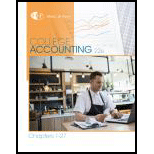
College Accounting, Chapters 1-27 (New in Accounting from Heintz and Parry)
22nd Edition
ISBN: 9781305666160
Author: James A. Heintz, Robert W. Parry
Publisher: Cengage Learning
expand_more
expand_more
format_list_bulleted
Question
Chapter 19, Problem 4RQ
To determine
State the values in which the noncash assets must be taken over by the
Expert Solution & Answer
Trending nowThis is a popular solution!

Students have asked these similar questions
Chapter 15 Homework
13
Saved
Help
Save & Exit Submit
Part 1 of 2
0.83
points
eBook
Ask
Required information
Use the following information to answer questions. (Algo)
[The following information applies to the questions displayed below.]
Information on Kwon Manufacturing's activities for its first month of operations follows:
a. Purchased $100,800 of raw materials on credit.
b. Materials requisitions show the following materials used for the month.
Job 201
Job 202
Total direct materials
Indirect materials
Total materials used
$ 49,000
24,400
73,400
9,420
$ 82,820
c. Time tickets show the following labor used for the month.
Print
References
Job 201
$ 40,000
Job 202
13,400
Total direct labor
53,400
25,000
$ 78,400
Indirect labor
Total labor used
d. Applied overhead to Job 201 and to Job 202 using a predetermined overhead rate of 80% of direct materials cost.
e. Transferred Job 201 to Finished Goods Inventory.
f. Sold Job 201 for $166,160 on credit.
g. Incurred the following actual other…
quesrion 2
Anti-Pandemic Pharma Co. Ltd. reports the following information in
its income statement:
Sales = $5,250,000;
Costs = $2, 173,000;
Other expenses = $187,400;
Depreciation expense = $79,000;
Interest expense= $53,555;
Taxes $76,000;
Dividends $69,000.
$136,700 worth of new shares were also issued during the year and
long-term debt worth $65,300 was redeemed.
a) Compute the cash flow from assets
b) Compute the net change in working capital
(325 marks)
Chapter 19 Solutions
College Accounting, Chapters 1-27 (New in Accounting from Heintz and Parry)
Ch. 19 - Prob. 1TFCh. 19 - Prob. 2TFCh. 19 - Prob. 3TFCh. 19 - Prob. 4TFCh. 19 - Prob. 5TFCh. 19 - Prob. 1MCCh. 19 - Prob. 2MCCh. 19 - Prob. 3MCCh. 19 - Prob. 4MCCh. 19 - Prob. 5MC
Ch. 19 - Prob. 1CECh. 19 - Prob. 2CECh. 19 - Prob. 3CECh. 19 - Prob. 4CECh. 19 - Prob. 5CECh. 19 - Prob. 1RQCh. 19 - Prob. 2RQCh. 19 - Prob. 3RQCh. 19 - Prob. 4RQCh. 19 - Prob. 5RQCh. 19 - Prob. 6RQCh. 19 - Prob. 7RQCh. 19 - Prob. 8RQCh. 19 - Prob. 9RQCh. 19 - Prob. 1SEACh. 19 - Prob. 2SEACh. 19 - Prob. 3SEACh. 19 - Prob. 4SEACh. 19 - ENTRIES: PARTNERSHIP LIQUIDATION On liquidation of...Ch. 19 - Prob. 6SPACh. 19 - Prob. 7SPACh. 19 - Prob. 8SPACh. 19 - Prob. 9SPACh. 19 - STATEMENT OF PARTNER SHIP LIQUIDATION WITH LOSS...Ch. 19 - Prob. 1SEBCh. 19 - Prob. 2SEBCh. 19 - Prob. 3SEBCh. 19 - Prob. 4SEBCh. 19 - Prob. 5SEBCh. 19 - Prob. 6SPBCh. 19 - Prob. 7SPBCh. 19 - ENTRIES FOR DISSOLUTION OF PARTNERSHIP Cummings...Ch. 19 - Prob. 9SPBCh. 19 - STATEMENT OF PARTNER SHIP LIQUIDATION WITH LOSS...Ch. 19 - Prob. 1MYWCh. 19 - Prob. 1ECCh. 19 - Prob. 1MPCh. 19 - Prob. 1CPCh. 19 - Prob. 1COP
Knowledge Booster
Similar questions
- QS 15-18 (Algo) Computing and recording over- or underapplied overhead LO P4 A company applies overhead at a rate of 170% of direct labor cost. Actual overhead cost for the current period is $1,081,900, and direct labor cost is $627,000. 1. Compute the under- or overapplied overhead. 2. Prepare the journal entry to close over- or underapplied overhead to Cost of Goods Sold. Complete this question by entering your answers in the tabs below. Required 1 Required 2 Compute the under- or overapplied overhead.arrow_forwardQuestion 6 During 2019, Bitsincoins Corporation had EBIT of $100,000, a change in net fixed assets of $400,000, an increase in net current assets of $100,000, an increase in spontaneous current liabilities of $400,000, a depreciation expense of $50,000, and a tax rate of 30%. Based on this information, what is Bitsincoin's free cash flow? (3 marks)arrow_forwardQuestion 4 Waterfront Inc. wishes to borrow on a short-term basis without reducing its current ratio below 1.25. At present its current assets and current liabilities are $1,600 and $1,000 respectively. How much can Waterfront Inc. borrow? (5 marks)arrow_forward
arrow_back_ios
SEE MORE QUESTIONS
arrow_forward_ios
Recommended textbooks for you
 College Accounting, Chapters 1-27AccountingISBN:9781337794756Author:HEINTZ, James A.Publisher:Cengage Learning,Principles of Accounting Volume 1AccountingISBN:9781947172685Author:OpenStaxPublisher:OpenStax College
College Accounting, Chapters 1-27AccountingISBN:9781337794756Author:HEINTZ, James A.Publisher:Cengage Learning,Principles of Accounting Volume 1AccountingISBN:9781947172685Author:OpenStaxPublisher:OpenStax College

College Accounting, Chapters 1-27
Accounting
ISBN:9781337794756
Author:HEINTZ, James A.
Publisher:Cengage Learning,

Principles of Accounting Volume 1
Accounting
ISBN:9781947172685
Author:OpenStax
Publisher:OpenStax College



